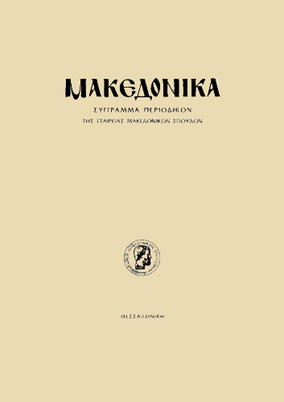Παρατηρήσεις στην εικονογραφία του βίου του Αγ. Ιωάννη Χρυσοστόμου : δυο μοναστικά σύνολα από τις Σέρρες και το Άγιον Όρος
Part of : Μακεδονικά ; Vol.32, 2000, pages 165-184
Issue:
Pages:
165-184
Parallel Title:
Observations on the Iconography of the Life of St. John Chrysostom: : Two Monastic Ensembles from Serres and Mount Athos.
Section Title:
Articles
Author:
Abstract:
This publication focuses on the iconography of the life of St. John Chry sostom and is based on the study of two sets of wall-paintings dating from the 17th century. One lies in the south portico of the catholicon of the Monastery of St. John the Baptist (Timiou Prodromou) near Serres, where the most recent layer of wall-paintings dates from 1630, and the other, which dates from 1695, lies in the Chapel of St. John Chrysostom housed on the third floor of the Monastery of Dionysiou on Mount Athos. In the Serres monument, amongst the wealth of representations that exists, there are five extensive scenes referring to episodes from the life of St. John Chrysostom, forming a kind of synaxarion, or account of the saint’s life. In the Athonite chapel, amongst other representations, stand out eight scenes which have been drawn from the life and miracles of the honoured saint. A comparison of the scenes relating to the life of St. John Chrysostom in these two monastic monuments from the 17th century enables us to make a few observations on the iconography of the saint, based on a study of both mo numental painting and depictions in portable icons and illuminated manu scripts. As far as we know, no comprehensive monograph on the life of the saint currently exists, while there is a richer bibliography on individual episo des from his life. On the basis of the examination carried out here, both of the sources and the illustrated examples, the following conclusions have been drawn. A complete iconographical cycle of the life of St. John Chrysostom had already developed during the Byzantine era, consisting of a set number of scenes, and this was further developed and enriched with other related scenes during the post-Byzantine era. Having made these observations, we can no longer accept the view of Chr. Walter, who claims in one of his studies that there is no complete iconographical cycle of the life of St. John Chrysostom, insisting that only individual scenes exist. The theory held by the Byzantino- logist A. Xyngopoulos seems to be nearer the truth: in an article published in 1971, Xyngopoulos claimed that a complete iconographical cycle of the life of St. John did exist during the Byzantine era, but only partial representations of it still survived. This convincing interpretation is undoubtedly confirmed by the observations made in this study, based on the relevant wall-paintings from these two historical monasteries of northern Greece.
Notes:
856:https://ejournals.epublishing.ekt.gr/index.php/makedonika/article/view/5730, DOI: https://doi.org/10.12681/makedonika.169
Electronic Resources:




